First Thanksgiving: The Real Menu

Discover more detailed and exciting information on our website. Click the link below to start your adventure: Visit Best Website tecfai.com. Don't miss out!
Table of Contents
First Thanksgiving: The Real Menu – Beyond the Myth
The image of the First Thanksgiving is deeply ingrained in our collective consciousness: pilgrims and Native Americans sharing a bountiful harvest feast, laden with roasted turkey, stuffing, cranberry sauce, and pumpkin pie. But how accurate is this picture? The truth, as with most historical events, is far more nuanced and fascinating than the romanticized version. Let's delve into the real menu of the First Thanksgiving, separating fact from fiction.
Dispelling the Myths: What Wasn't on the Table
Before we explore what was likely served, let's address some common misconceptions. The iconic image of a perfectly roasted turkey, for instance, is largely a product of later artistic interpretations. While wildfowl was undoubtedly present, the exact type remains uncertain. Turkey might have been on the menu, but it wasn't the centerpiece as modern tradition suggests. Furthermore, elements like cranberry sauce and pumpkin pie are decidedly not historical additions; these are much later culinary inventions.
The Lack of Standardized Recipes
It's crucial to understand that the concept of a standardized Thanksgiving menu didn't exist in the 17th century. Recipes as we know them were far less common, and the food preparation methods differed significantly from our modern practices. The focus was on preserving and utilizing the harvest, leading to a far more varied and likely less predictable spread than we envision today.
A Glimpse into the Authentic First Thanksgiving Feast
So, what did the pilgrims and Wampanoag people eat? Historians and food experts have pieced together a probable menu based on accounts from the time period and the known foods available in the region:
Wild Game: The Main Course
Venison, waterfowl (including ducks, geese, and possibly swans), and other wild game were likely the main proteins. These would have been cooked over open fires, possibly roasted or stewed. Remember, domesticated animals like chickens and turkeys weren't as prevalent then.
Seafood: A Coastal Bounty
Given the proximity to the ocean, seafood was undoubtedly a significant part of the meal. Clams, mussels, lobster, and fish were abundant and easily harvested, providing a crucial source of protein.
Vegetables and Grains: The Harvest's Abundance
The harvest yielded various vegetables like squash, beans, peas, and corn. These were likely served boiled or roasted, offering a crucial source of carbohydrates and nutrients. Additionally, grains like barley and perhaps wheat were present, perhaps in the form of porridge or bread.
Fruits and Nuts: Seasonal Sweetness
Wild berries, nuts (like acorns and walnuts), and possibly dried fruits contributed sweetness and added nutritional value to the feast. These items would have provided a natural source of sugar before refined sugar became commonplace.
The Importance of Shared Culture and Collaboration
The real story of the First Thanksgiving goes beyond the food itself. It highlights the significant collaboration between the Pilgrims and the Wampanoag, showcasing a period of shared harvest and, importantly, a temporary alliance. The meal was a symbol of this interaction, a testament to the potential for cooperation and cultural exchange.
Conclusion: A More Realistic Thanksgiving
The "real" First Thanksgiving menu was far less predictable and significantly less refined than our modern Thanksgiving feasts. While the romanticized image provides a heartwarming narrative, understanding the historical context allows for a deeper appreciation of the event and the complexities of the relationship between the Pilgrims and the Wampanoag. Focusing on the spirit of sharing and gratitude, rather than adhering to a specific menu, is a more authentic way to celebrate this historical occasion.

Thank you for visiting our website wich cover about First Thanksgiving: The Real Menu. We hope the information provided has been useful to you. Feel free to contact us if you have any questions or need further assistance. See you next time and dont miss to bookmark.
Featured Posts
-
Drew Starts De Vito Inactive Giants
Nov 29, 2024
-
Thanksgiving 2024 Black Friday Deals
Nov 29, 2024
-
As Roma Vs Tottenham Confirmed Starting Xi
Nov 29, 2024
-
Thanksgiving Halftime Shaboozeys Performance
Nov 29, 2024
-
Macys Thanksgiving Parade History
Nov 29, 2024
